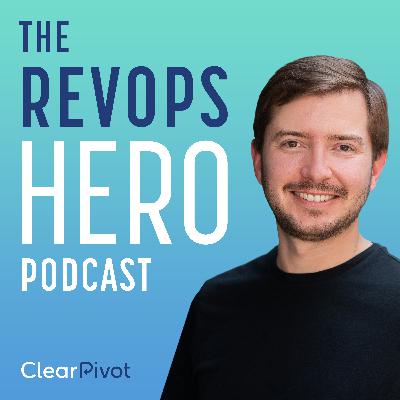Discover The RevOps Hero Podcast
The RevOps Hero Podcast

The RevOps Hero Podcast
Author: ClearPivot
Subscribed: 2Played: 5Subscribe
Share
© ClearPivot
Description
The RevOps Hero Podcast will teach you how to improve and advance your company's revenue operations and your own career. Our clear, concise explanations will help you understand how new developments in the CRM, marketing automation, and data world will affect your company's customer journey lifecycle and pipeline.
56 Episodes
Reverse
We're doing something different in this episode. We recorded it at HubSpot's INBOUND conference, and rather than having just one single episode guest, we interviewed marketing and RevOps leaders from 5 very different companies—each with their own specific approach to attracting, converting, and retaining customers.You'll hear how companies structure their go-to-market motions across:- Inbound marketing and demand generation- SDR/AE handoffs and deal stage workflows- Self-serve vs. high-touch enterprise sales- Attribution tracking and reporting- Event-based field marketing and referral programs- Long-cycle sales driven by print and local ads👥 Featured guests:- Tim Phelps, First Orion- Carmen Bodziak, Goodshuffle- Tanya Littlefield, Amplitude- Eryn Lueders, Basis Theory- Nathaniel Frisch, United Energy Workers HealthcareWhether you're running a SaaS company, a healthcare organization, or anywhere in between, this episode gives you real-world insights into how others make GTM work.📌 Got a unique GTM process at your company? Drop it in the comments to let us know. We'd love to hear about it.
In this episode of the RevOps Hero Podcast, host Chris Strom is joined by ClearPivot teammate Andrew Chao Daongam to break down what companies need to know before, during, and after onboarding with HubSpot.With over 80 successful onboardings under his belt, Andrew shares practical insights on:✅ The 3 main types of HubSpot onboarding projects✅ Setting realistic expectations for guided onboarding✅ The most common goals—and common mistakes—for Sales, Marketing, and Service Hub onboardings✅ Why your internal process mapping must come before system configuration✅ How to avoid deliverability disasters in email marketing✅ What to plan before you buy HubSpot to get quicker winsWhether you’re migrating from another CRM, building your first RevOps stack, or adding HubSpot into an existing system, this episode is full of tactical guidance to help your team succeed from day one.
Configure-Price-Quote (CPQ) platforms have come a long way from the days of spreadsheet formulas. In this conversation, host Chris Strom and RevOps strategist Joanne Cheng unpack where CPQ fits in a modern go-to-market stack, the problems it actually solves, and how new developments, such as AI-driven guidance, usage-basedbilling, and low-code extensibility, are reshaping the space.Listen in for:A clear-spoken CPQ primer: what it is, what it isn’t, and the tipping points that signal it’s time to adopt.Real-world patterns that demand more than manual quoting—think multi-currency deals, complex product bundles, or fast-moving self-serve funnels.Emerging trends for 2025, from composable quote-to-cash architectures to the rise of predictive discount recommendations.Candid lessons from recent rollouts—what sped things up, what slowed things down, and how alignment between the involved stakeholders make or break success.A myth-busting round (yes, spreadsheets can still play a supporting role).Whether you’re revenue-ops-curious or knee-deep in a CPQevaluation, this episode offers a balanced, jargon-light look at the tech and the tactics behind smoother quoting flows.Grab your headphones, hit play, and enjoy the chat!
In this episode of the RevOps Hero Podcast, host Chris Strom sits down with Jacqueline Freedman of Monarch Advisory Partners and former Marketing Ops leader at Grammarly and WeWork, to dive deep into the strategy, planning, and execution of in-person events as part of your marketing operations.Together, they unpack:✅ Why in-person events are regaining importance in today’s remote-first world✅ How to align sales and marketing before, during, and after your event✅ What types of events (from CABs to fireside chats) work best and why✅ Tools and tech stacks for tracking attendance and engagement✅ How to define success through metrics like pipeline generation and incremental impact✅ Pro tips on campaign setup, reporting, and segmentation in systems like Salesforce and HubSpot✅ What not to do in post-event follow-up (hint: don’t blast your attendee list to sales)Whether you’re planning your first executive dinner or scaling a multi-city roadshow, this episode is packed with practical guidance to help your team turn in-person events into measurable marketing wins.
Companies have crucial data stored across multiple systems in their organization. And the bigger the company, the more systems there are. Sales, marketing, finance, ERP, inventory, contract management, billing, and service delivery are just types of data and systems that show the story of the business. Many times your CRM just by itself can't show all of that!Because of this, many companies have started setting up a centralized data warehouse like Snowflake or Redshift to pull in data from their CRM and other systems to be able to run more advanced and centralized reporting across it all. But if you want to set this up, where do you start? How do you manage it? How do you protect it? How do you keep it maintained? How do you actually derive value from all the hard work of implementing it?I contacted Ryan Severns to talk through all these questions with him. We talk through all these questions and more, starting with questions like:Why set up a CRM <-> data warehouse infrastructure in the first place?How do you build the integration?What important considerations do you need to plan for?We dig deeper into the details from there, talking through topics like ETL tooling, DBT, data governance, cross-platform analytics, building effective business intelligence systems, and more.If you’re ready to level up your customer data skills and advance to the next level of your RevOps hero journey, this episode is for you! Give it a watch and a like. And hit that subscribe button so that you’ll always get notified of future episodes of The RevOps Hero Podcast as well.
Running a Salesforce-HubSpot go-to-market stack is one of the most common tech setups in businesses today. Many businesses manage it using HubSpot's native Salesforce integration. But some businesses instead choose to build their own custom integration. Why would they do that? Should your company consider custom-building your HubSpot-Salesforce integration as well?
We talk with Erick Salvatierra on this exact topic. We discuss topics like:
When should you use the standard HubSpot-Salesforce integration?
When would a custom integration be better? We discuss specific factors including: sync frequency requirements, field mapping requirements, number of records to sync, compliance requirements, and more.
If you decide to build a custom integration, how should you do it?- After the integration is built, how should you do maintenance and error handling?
When should you use an iPaaS / middleware solution vs. fully custom-coding an integration?
Why should you bother with integration at all?
If you're running Salesforce and HubSpot at a medium- or large-sized company, this episode will be incredibly valuable for you. So give it a like and a watch, and hit that subscribe button so that you never miss any future episodes of The RevOps Hero Podcast.
Over the past year, I’ve noticed a growing confusion among marketers and sales professionals about the different types of email tools—and it’s leading to serious consequences.
In this video, I delve into the two main types of sales and marketing email tools: 1:many and 1:1. Understanding the distinction isn’t just technical—it’s essential for protecting your email domain reputation and ensuring your messages reach the intended audience.
🔍 In this episode we discuss:
What are 1:many email tools and how they work
What are 1:1 email tools and how they work
How email providers like Gmail and Outlook filter your messages—and how to land in the Primary tab
How you could jeopordize your personal email deliverability without even realizing it
Key things you need to do to maintain compliance and avoid getting flagged as spam
Don’t let a simple misunderstanding derail your marketing efforts. If you’re sending emails—whether to one person or one million—you need to see this.
Hit play to safeguard your email operations and boost your campaign success. 👊
We do a deep dive into marketing operations with Lauren Sanyal in this episode. 🤘 We start off by talking with Lauren about how they structure their marketing ops and RevOps teams within her company, and how they decide who reports to who.From their we talk through how they run their marketing and revenue tech stack using Salesforce and Marketo. Lauren and her team run a very meticulous Salesforce campaign structure for organizing and tracking all of their marketing activities. We discuss the how and why of their Salesforce campaign setup. Many companies under-utilize the campaigns in their Salesforce orgs, so there is a lot that other marketing ops people can learn from Lauren and her team here!We then talk through how Lauren and her team run marketing attribution at her company. Their sales cycle is very long (1-2 years), so a well-planned multi-touch attribution model is critical for getting insight into the effectiveness of all the marketing and sales activities that Lauren's team is doing over the course of that time. We talk through what tools and data they use for multi-touch attribution, what events they track, which events are weighted more than others and why, and more. If you are struggling to track the effectiveness of all your marketing activities over a similar super-long sales process, you will want to take a lot of notes in this section. 📝We wrap up by talking about when is the right time for a company to start investing in marketing operations specifically versus more marketing generalist roles (hint: it's probably sooner than you might think.)Give this episode a like and a listen, and subscribe to our show so that you won't miss out on any future episodes of The RevOps Hero Podcast while you're at it. 🙌
The go-to-market motion for product-led growth (PLG) SaaS companies is VERY different from sales-led growth companies.➡️ The contact lifecycle/funnel stages are different➡️ The data/system architecture is different➡️ The relationship between the CRM and billing systems are different.➡️ The key funnel conversion rates are different.Instead of setting up sales pipelines, hiring Account Executives, and managing territories, you’re doing defining custom in-app behavior triggers, you’re integrating your CRM to your app user records or intermediary tools like data warehouses, and you’re tracking a very different set of success metrics. And the sheer amount of data will usually be significantly larger as well.What is the best way to run a CRM and marketing system like HubSpot for PLG SaaS companies like this?Emma Cimolini knows a thing or two about this subject. She’s been using HubSpot to build out go-to-market systems for SaaS startups and big publicly traded software companies for years. She’s built and launched multiple growth teams and has deep experience in building productive relationships with sales teams.In this episode, we talk through how to set up HubSpot to run product-led growth motions for SaaS companies. We discuss:1️⃣ How to set up your system architecture and data architecture between HubSpot and different systems like your app databases, data warehouses, app analytics tools, web analytics tools, and billing systems2️⃣ How and when to decide whether HubSpot or your data warehouse should be your company’s primary source of truth3️⃣ How to make the case to get engineering resources for building your PLG funnel4️⃣ How to map out PLG-focused contact lifecycle stages in HubSpot5️⃣ What to watch out for when reporting on MRR and other financial metrics between HubSpot and your billing system6️⃣ Technical constraints to watch out for in terms of API limits, multi-object reporting, data management, and engineering development timeThis is a must-watch episode for anyone working in go-to-market teams at PLG-focused SaaS companies!And if you’re at a company that runs Salesforce as your CRM rather than HubSpot, this episode will also apply to you as well. Most of the topics we cover here are equally as important to companies running Salesforce or other CRMs as companies running HubSpot by itself.Give this episode a listen and learn what you need to know for building up a killer go-to-market motion for your PLG-focused company.
RevOps is the backbone of a company. It touches every business function: marketing, sales, customer success, finance, operations, and IT. But when a role touches a little bit of everything, how do you concisely define what that role itself is? Where does it fit in your company structure? Who should RevOps report to?We talk through all of these things in this episode with Brandon Dith-Berry. We then move on to discussing the systems architecture that Brandon has implemented at his company Zeni: what are the different systems they're running, and how they structure and pass data between their CRM system (HubSpot), their billing system, their user analytics system, and their custom-built internal tools. There's a lot of meat on the bone in this episode!Give Brandon Dith-Berry a connect or a follow on LinkedIn here: https://www.linkedin.com/in/brandondithberry/Learn more about ClearPivot and how we help turn people like you into RevOps heroes at your company here: https://www.clearpivot.com
In this episode we talk with Nick Jensen, who runs marketing operations for the world-famous Tony Robbins. Nick and his teammates run a marketing-sales operation with a contact database in the millions, using Salesforce and HubSpot together to run their operations.We talk about: The similarities and difference between their B2C and B2B customer lifecycles and sales pipelines How they connect HubSpot to Salesforce for people objects compared to contact and account objects How they decide what object and event data to sync between Salesforce and HubSpot How they run large-scale email marketing (40 million emails per month) What are the top sales and marketing KPIs that they track How they set up a custom object in Salesforce and HubSpot to track key contact activities as well as affiliate tracking Similarities and differences between their prior Salesforce-Marketo integration and their current Salesforce-HubSpot integrationGive this episode a watch or a listen to learn how to run a high-impact marketing and revenue operations systems across Salesforce and HubSpot running at large scale. 🤘You can connect with Nick Jensen on LinkedIn here: https://www.linkedin.com/in/nicholasljensen/Learn more about ClearPivot and how we build high-impact revenue operations systems for companies here: https://www.clearpivot.com
Ever run into friction with the sales team in a marketing role? You'll want to listen to this episode. We go deep into the full marketing-sales lifecycle in this episode with our guest Kristina McConnell from H1. She talks through how they run the full customer journey from marketing leads to BDR qualification to Account Executive handoff.We cover topics such as: How to manage contact lifecycle stages throughout the process How Kristina tracks attribution data through the process How Kristina and her team have integrated HubSpot and Salesforce to track their full customer journey How Kristina approaches marketing for a product with heavy awareness-building needs How to best equip sales reps with relevant prospect intelligenceGive this episode a listen and learn how to better work with your colleagues on the sales team so that you can all win together. 🤘
In this episode we go into the operational side of marketing: how to run all the systems and data that power a company's sales and marketing efforts. We talk to Travis Johnson, who leads marketing operations at Velo3D.We talk through how they run Salesforce and Marketo together, how they structure their data in the systems, how they do campaigns, attribution, and lead scoring, and much more.Give this episode a listen to learn from Travis how to built out a whip-smart operational machine for your own company's marketing engine.
It's easy to get overwhelmed with the amount of data and metrics that sales and marketing tools report on nowadays. You can get pages and pages of metrics from platforms like HubSpot, Google Analytics, Salesforce, Meta Ads Manager, and so on. How do you know which metrics are the most important and which you should ignore? In this episode, we walk through which key sales and marketing metrics we track for ourselves at ClearPivot.
You can have the greatest marketing campaign ever and still see your company miss its goals if you don't have a rock-solid sales process to back it up. So it's crucial to get your sales pipeline process running as well as your marketing campaigns. But where and how should you start? In this episode, ClearPivot founder Chris Strom walks through how we run our own sales pipeline process at ClearPivot. Give this episode a listen, and you will come away with some actionable ideas to apply to your own company's sales process, so that the sales team will be hitting their numbers more and you will look like even more of a Marketing Hero at your company.
Marketing teams nowadays spend a LOT of time managing their website. And WordPress is the most common platform choice for managing company websites. But WordPress has severe risks and liabilities that we believe make it a poor choice for most company websites nowadays. In this episode we talk about 6 specific reasons why WordPress is a bad choice for most companies' websites, and why we recommend using HubSpot Content Hub instead.
Web analytics don't tell the full story. ClearPivot Founder Chris Strom joins The Marketing Hero to explain the limitations of web analytics like source tracking, and advocate for asking people directly, "How did you find us?" Listen for important details on how to use web analytics and self-reported attribution together to create a fuller picture of how your company is attracting leads.
ClearPivot agency Founder Chris Strom discusses 5 common mistakes he's seen clients make over and over in his 13 years as a HubSpot partner, and suggests the best ways to combat them. Come on in, and find out if you've been over automating, leaving SQLs on the table, or doing one of these other common marketing mis-steps!
On episode 38 of The Marketing Hero Podcast, we're joined by Zack Wenthe, Senior Technical Product Marketing Manager and product evangelist for Treasure Data. It's a customer data platform that aims to help businesses reclaim customer-centricity by focusing on purposeful engagement. We'll dive into what that means and how CDPs deal with questions of data privacy and tightening regulations along with some personal insights into Zack's career.
On today’s episode of The Marketing Hero podcast, we're talking with Dave Fink, Founder and CEO of Postie. Over a 20-year career he’s generated hundreds of millions of dollars in ad revenue, powered viral sensations like Dollar Shave Club, and helped launch celebrity startups for Jessica Simpson, Mary-Kate and Ashley Olsen, and Kate Bosworth. Now as founder and CEO of Postie, he’s out to reinvent direct mail marketing for a digital world. Our conversation focuses on the story of how Postie developed and executed their own go-to-market strategy and marketing plans. Spoiler: They went about it backwards.


















